birds

‘‘Akikiki - Oreomystis bairdi
The ‘Akikiki or Kaua’i creeper is a small, endangered Hawaiian honeycreeper endemic to Kaua’i. It has a dark gray to olive plumage, whitish underparts, pinkish legs and feet, and a short pink bill. This forest bird lives in pairs, family groups, or flocks and forages for insects and spiders by probing bark, lichens, and moss on trees. ‘Akikiki nest high in trees, with peak nesting from March to June, and produce 1-2 eggs per clutch. The species has undergone severe population declines, with only about 500 birds remaining due to habitat loss and threats like disease, predators, and storms. Conservation efforts include habitat restoration, captive breeding, predator control, and further research on the life history and ecology of the ‘Akikiki.
ʻĀkepa (Hawaiʻi) - Loxops coccineus coccineus
The Hawai’i ‘Ākepa is a small endangered Hawaiian honeycreeper endemic to the island of Hawai’i. The males have bright orange plumage while females are grayish-green with a yellow breast band. This forest bird has an offset bill that aids its specialized feeding strategy of prying open buds and leaves to find insects. ‘Ākepa nest in cavities of old-growth ‘ōhi’a and koa trees, with females building the nest and both parents feeding the young. Though once widespread on Hawai’i, habitat loss and disease have restricted the species to small populations above 4,300 feet elevation. Conservation efforts focus on forest restoration, controlling predators like rats, and research on disease resistance and artificial nest cavities.
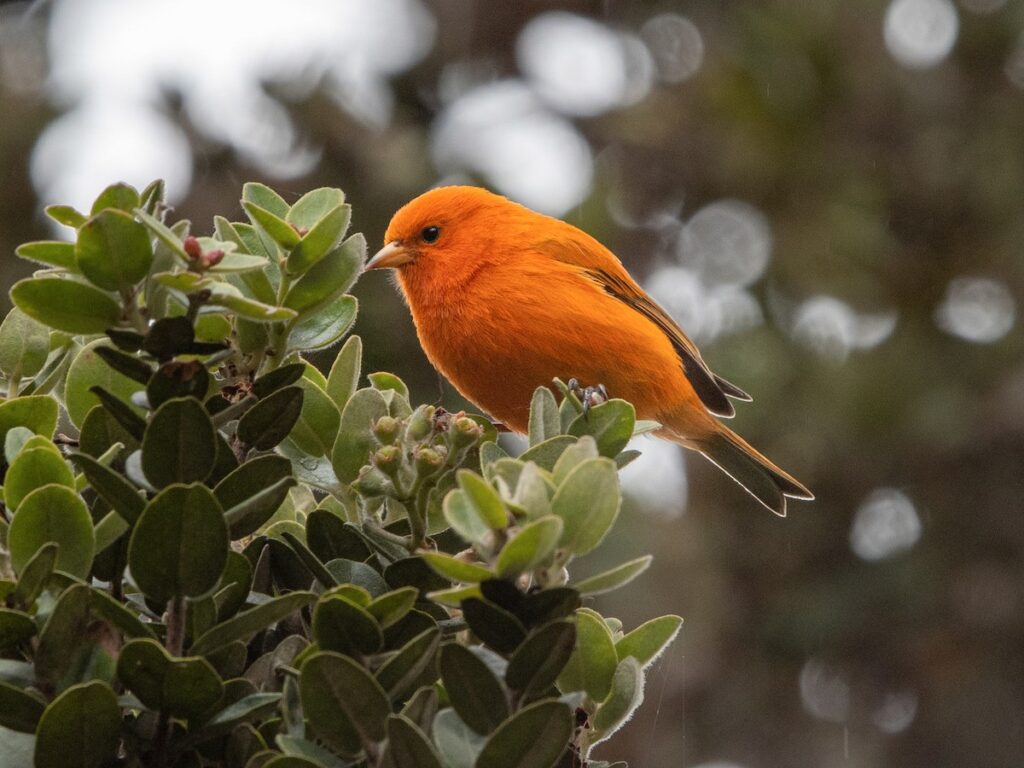
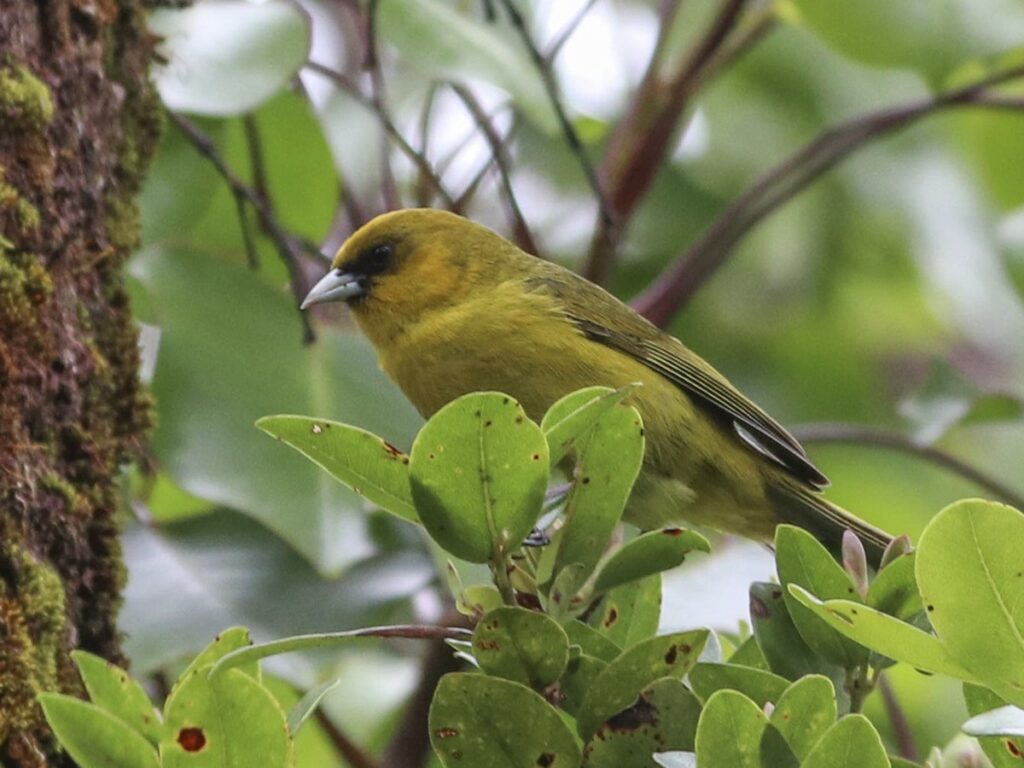
‘Akekeʻe - Loxops caeruleirostris
The ‘akeke’e is a small, insectivorous Hawaiian honeycreeper endemic to Kaua’i. It has greenish upperparts and yellow underparts with a yellow crown and black mask. It uses its distinctive bill to pry open ‘ohi’a leaves and buds while searching for arthropod prey. This ‘ohi’a specialist occurs in high elevation forests, builds nests in ‘ohi’a trees, and lays clutches of 2-3 eggs. Though once widespread, its population has declined precipitously and it now occupies only 10-12% of its former range. Avian malaria poses a severe threat to this critically endangered species.
ʻAkohekohe - Palmeria dolei
The ‘ākohekohe is the largest extant honeycreeper in Hawai’i, with striking black plumage tipped in orange, yellow, gray, silver, or white. It is primarily nectarivorous, feeding on the flowers of ‘ōhi’a trees, but also eats arthropods. Aggressive in defending feeding and nesting territories, females build open-cup nests in ‘ōhi’a trees. Once widespread across Maui Nui, the ‘ākohekohe is now restricted to a small area of northeastern Haleakalā at high elevations. Though the population seems stable, its limited distribution makes it vulnerable to disease and habitat degradation. Establishing a second wild population or captive flock are conservation priorities.
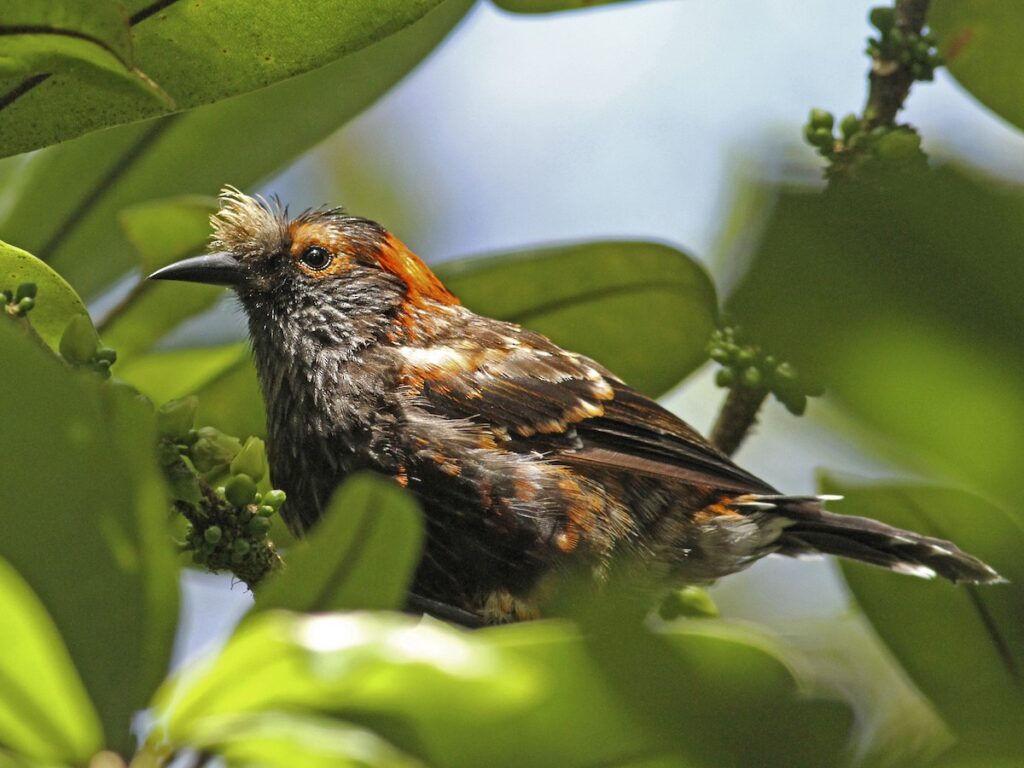
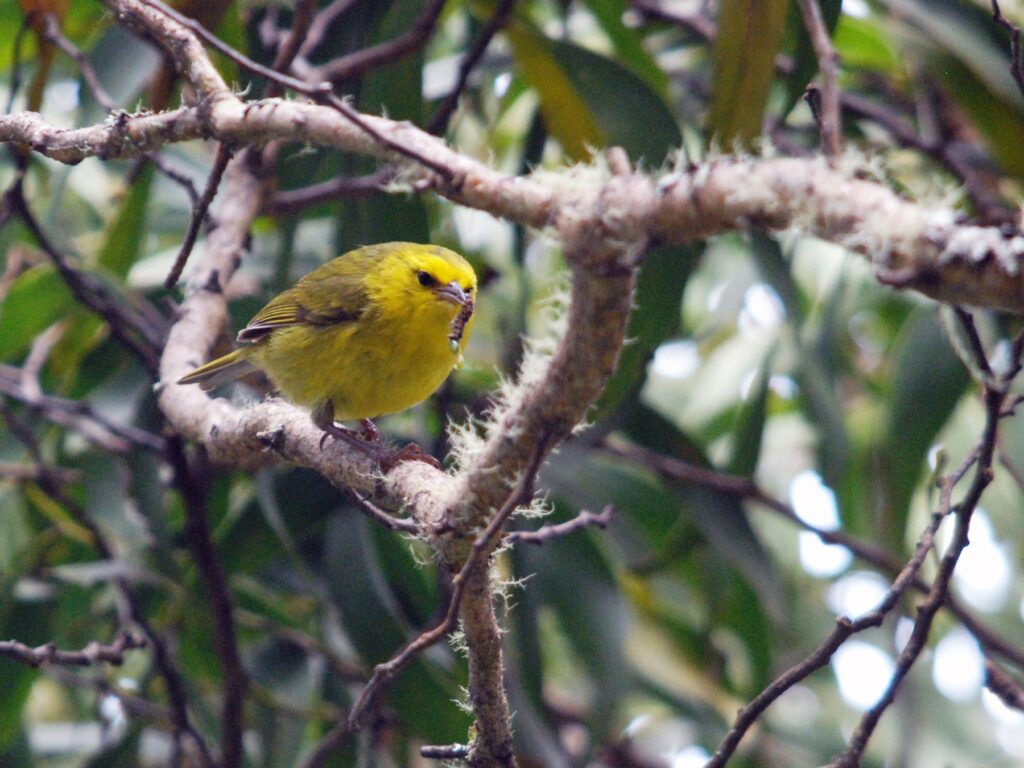
‘Alauahio (Maui) - Paroreomyza montana
The Maui ‘alauahio is a small, insectivorous Hawaiian honeycreeper endemic to Maui. Adult males are mostly olive-green with bright yellow faces, throats, and bellies, while females are duller. It gleans invertebrates from foliage and defends small territories year-round. Historically found across southeast Maui, it is now restricted to higher elevations on Haleakalā. Though still locally common, it faces threats from habitat degradation, non-native predators, and disease. Expanding predator control and forest restoration are conservation priorities for this species.
‘Alauahio (O‘ahu) - Paroreomyza maculata
The O’ahu ‘alauahio is a small, insectivorous Hawaiian honeycreeper endemic to O’ahu that is likely extinct. Males were olive-green with bright yellow underparts, while females were grayish-green and yellowish-white. It foraged by probing bark for insects and occupied mid-elevation forests. Restricted to O’ahu and declining when discovered, disease and habitat loss likely caused its extinction. No confirmed sightings exist since the 1980s, but surveys and monitoring could confirm if any birds remain. Research priorities for this potentially extinct species are limited.
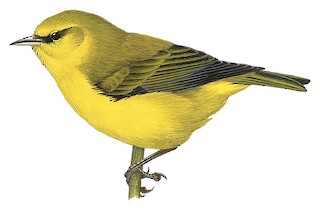
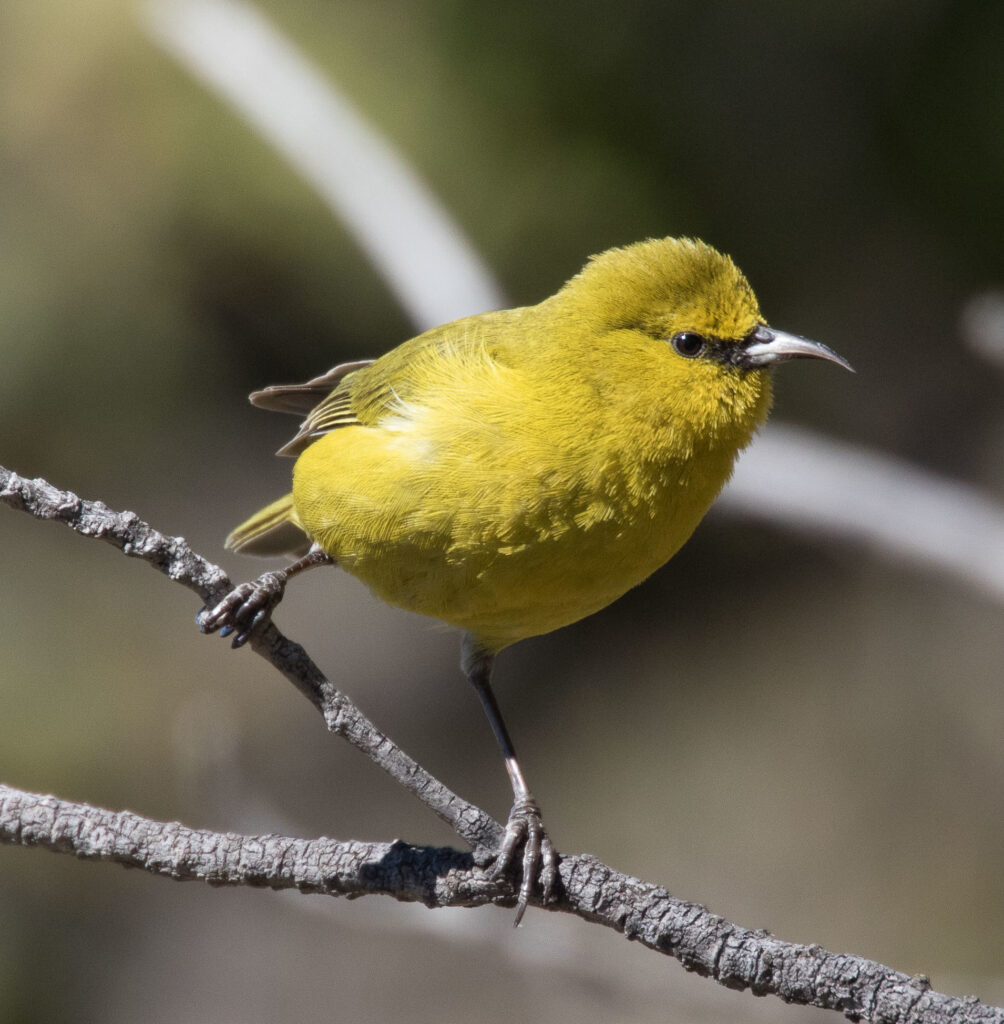
ʻAmakihi (Hawaiʻi) - Chlorodrepanis virens, Hemignathus virens
The Hawai‘i ‘amakihi is a small generalist honeycreeper found on Hawai’i, Maui, and Moloka’i. Males are yellow-green with black lores, while duller females have some inter-island variation. It gleans arthropods and feeds on nectar, resides in various native forest habitats, and breeds seasonally. Still common in upland forests, populations are likely stable on Hawai’i and Maui but may be declining on Moloka’i. Threats include habitat loss, non-native predators, and disease. Continued habitat protection and restoration, along with disease research and translocation efforts, are conservation priorities.
ʻAmahiki (Kauaʻi) - Chlorodrepanis stejnegeri, Hemignathus kauaiensis
The Kaua’i ‘amakihi is a small generalist honeycreeper endemic to Kaua’i. Males are yellow-green with black lores, while duller females glean insects from foliage and probe flowers. Found in high elevation wet forests, it builds nests in ‘ōhi’a trees and lays clutches of 3 eggs. Though still common in the Alaka’i region, it faces threats from habitat degradation, predators, and disease. Conservation priorities include controlling ungulates, removing non-native species, and conducting research on diseases and populations. Ongoing monitoring is also needed to detect any declines.

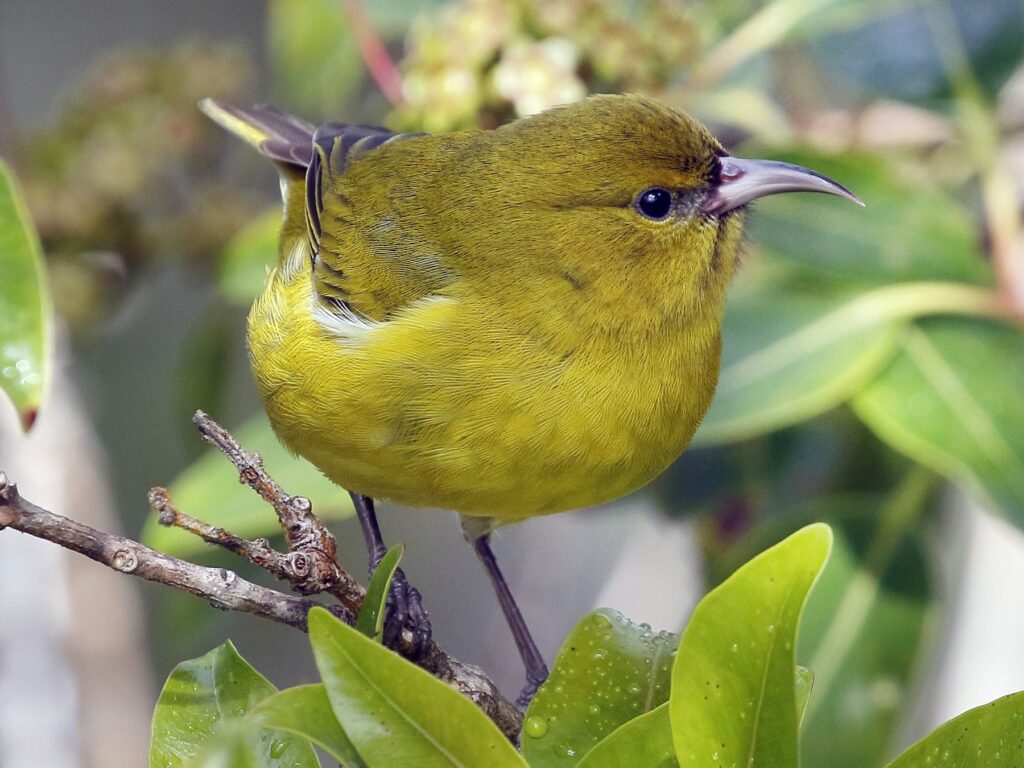
‘Amakihi (Oʻahu) - Chloroderpanis flava, Hemignathus flavus
The O’ahu ‘amakihi is a small generalist honeycreeper endemic to O’ahu. Males are yellow-green with black lores, while duller females glean insects and nectar from foliage. Though once widespread, it now occurs in two disjunct populations at middle elevations. Populations appear stable and may be increasing in some areas, utilizing native and non-native forest habitats. Threats include habitat degradation from invasive species and fire. Monitoring, research on disease resistance, and public education are conservation priorities for this resilient species.
ʻAnianiau - Maguuma parva, Hemignathus parvus
The ‘anianiau is the smallest Hawaiian honeycreeper, endemic to Kaua’i, with bright yellow males and duller females. It feeds on nectar and insects in native high elevation forests, defending small breeding territories. Though still common in the Alaka’i Wilderness, its range may be contracting from habitat degradation by invasive plants. Resistant to malaria, threats include competition with introduced species and predation. Maintaining habitat quality and controlling non-native species are conservation priorities for this diminutive bird. Ongoing monitoring is needed to detect further range contractions.
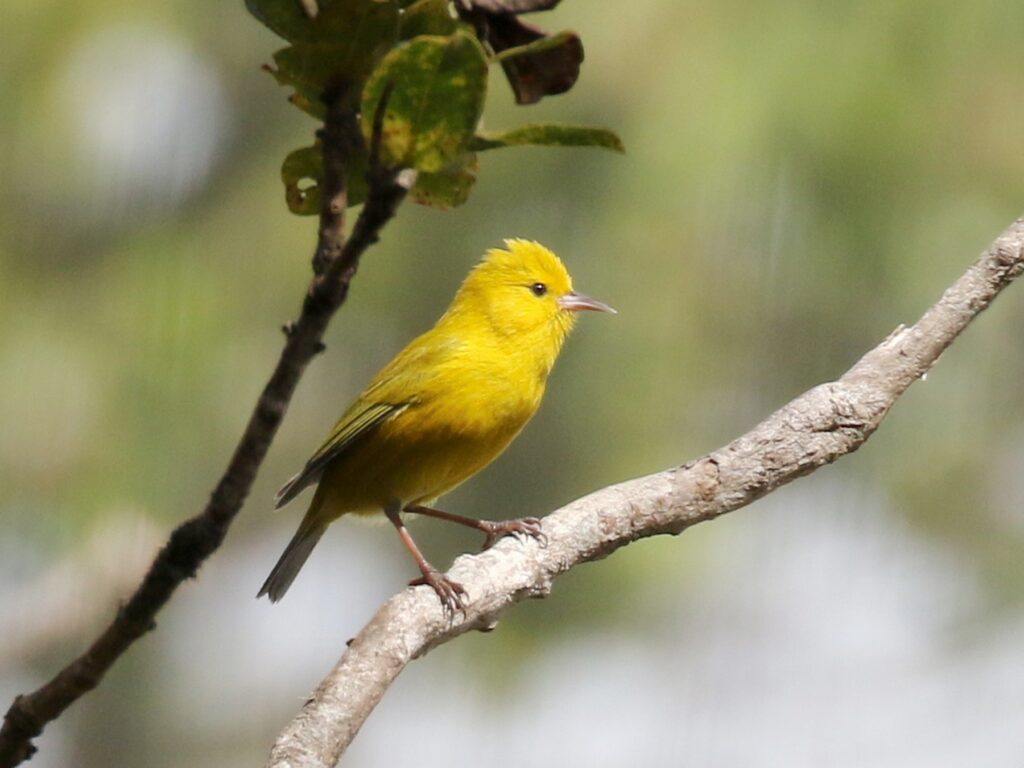
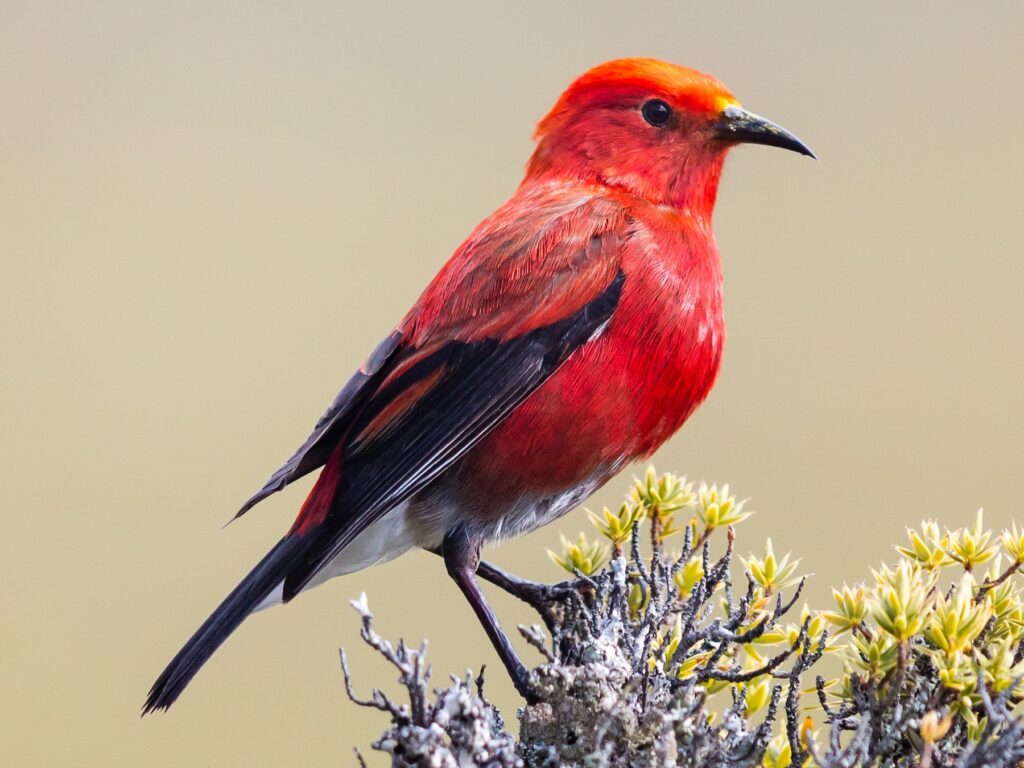
‘Apapane - Himatione sanguinea
The ‘apapane is a small, crimson, nectar-feeding honeycreeper that is the most abundant and widespread native Hawaiian forest bird. It forages for nectar and insects in ‘ohi’a forests above 1250 meters on Hawai’i, Maui, and Kaua’i. Population numbers seem stable on those islands, but it faces threats from introduced avian malaria and pox to which it is highly susceptible. Conservation efforts prioritize mosquito control, forest restoration, and habitat protection in key areas like wildlife refuges. Monitoring for population changes and research on disease resistance are vital for this iconic pollinator. Outreach is also needed on the importance of this abundant species.
ʻElepaio (Hawaiʻi) - Chasiempis sandwichensis
The Hawai‘i ‘elepaio is a small monarch flycatcher endemic to the island of Hawai‘i. It has dark brown plumage on its back and wings, with a white underside streaked with variable amounts of brown. Males have black throats while females have white throats. This adaptable bird forages by flycatching, gleaning, hovering and direct pursuit in trees and on the ground. It builds finely woven nests in which it typically lays 2 eggs per clutch. Though still common on Hawai‘i, it faces threats from habitat loss, non-native predators, and disease.
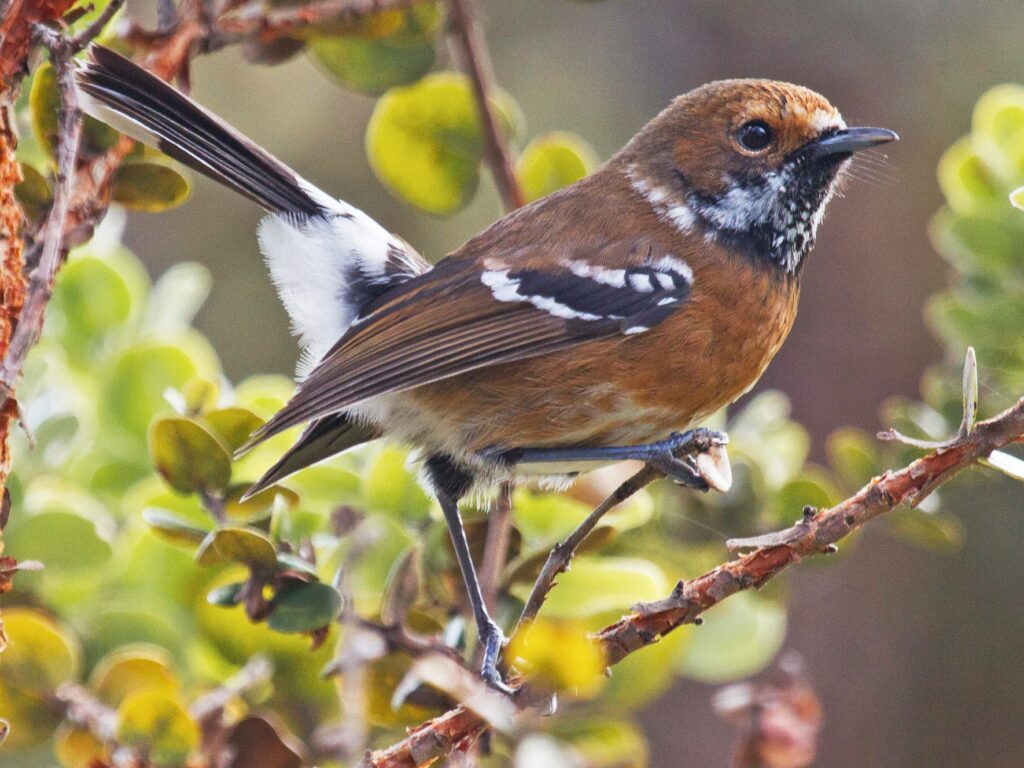

ʻElepaio (Kauaʻi) - Chasiempis sclateri
The Kaua‘i ‘elepaio is a small monarch flycatcher endemic to the island of Kaua‘i. It has grayish brown plumage on its crown and back, with white underparts and a rusty wash on its breast. Only the males sing the species’ distinctive shrill whistle. This adaptable bird likely forages on a variety of substrates and feeds on arthropods. It builds finely woven nests and lays 2 eggs per clutch. Though still common in high elevation forests, it faces threats from habitat degradation, non-native predators, and disease.
ʻElepaio (Oʻahu) - Chasiempis ibidis
The O‘ahu ‘elepaio is a small monarch flycatcher endemic to the island of O‘ahu. It has brown plumage on its back and wings, a white underside with brown streaks, and noticeable white wing bars. Only the males sing the species’ distinctive shrill whistle. This adaptable bird forages on various substrates and feeds on insects. It builds finely woven nests and lays 2 eggs per clutch. Now critically endangered, it faces severe threats from habitat loss, non-native predators, and disease.

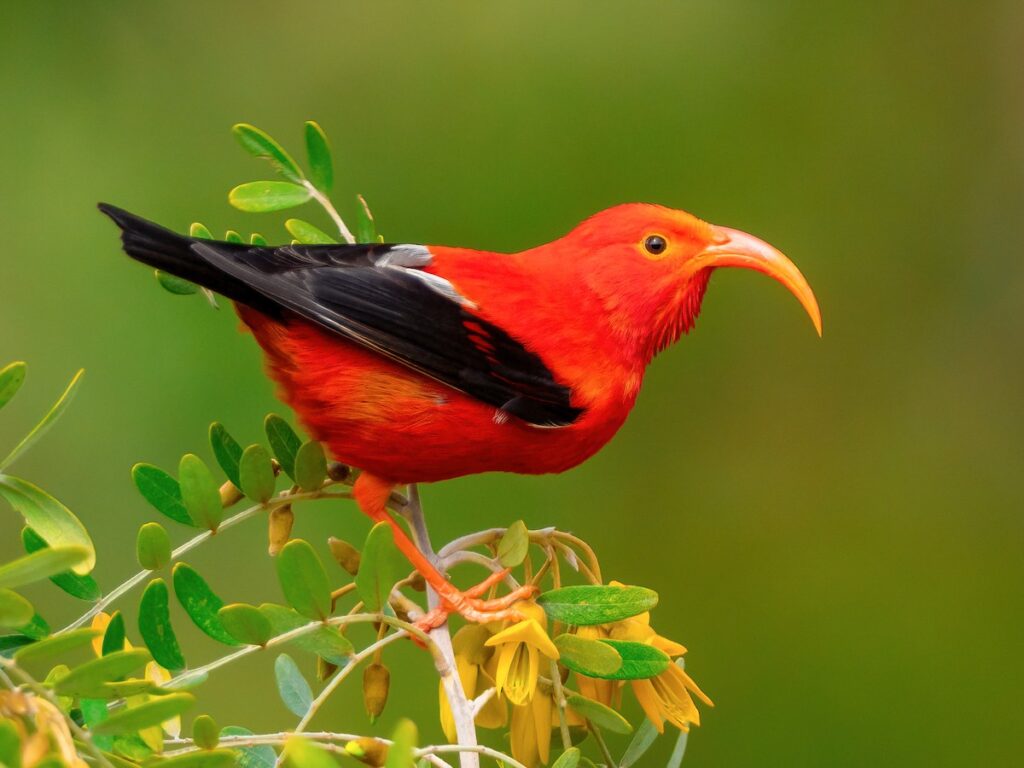
ʻIʻiwi - Vestiaria coccinea
The ‘i’iwi is a brilliant red Hawaiian honeycreeper found above 1250 meters on Hawai’i, Maui, and Kaua’i. It feeds on nectar and insects, pollinating ‘ōhi’a trees during long foraging flights. Though widespread, it is highly susceptible to introduced avian malaria and populations on O’ahu and Moloka’i are nearly extirpated. Remaining threats include habitat degradation and mosquito-borne diseases. Conservation requires continued habitat protection, mosquito control, and public education about this iconic species. Monitoring for population changes and research on disease resistance are also crucial.
ʻIo - Buteo solitarius
The ‘io is the only hawk native to Hawai’i, considered an ‘aumākua (family god) by Native Hawaiians. It preys on birds, rodents, and insects, nesting in native ‘ōhi’a or non-native trees. Though once found on other islands, it now occurs only on Hawai’i across a range of habitats. Proposed for delisting due to resilience, it may be impacted by habitat loss and introduced diseases. Monitoring, habitat protection, and research on fire and land use effects are conservation priorities. Outreach on its cultural significance is also important for this unique Hawaiian raptor.
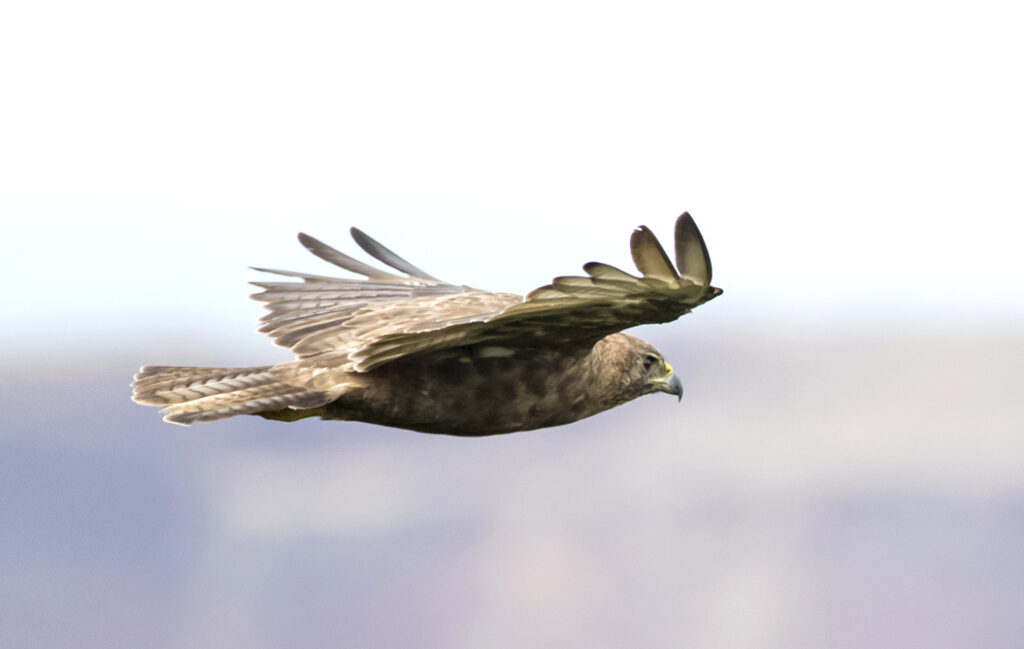
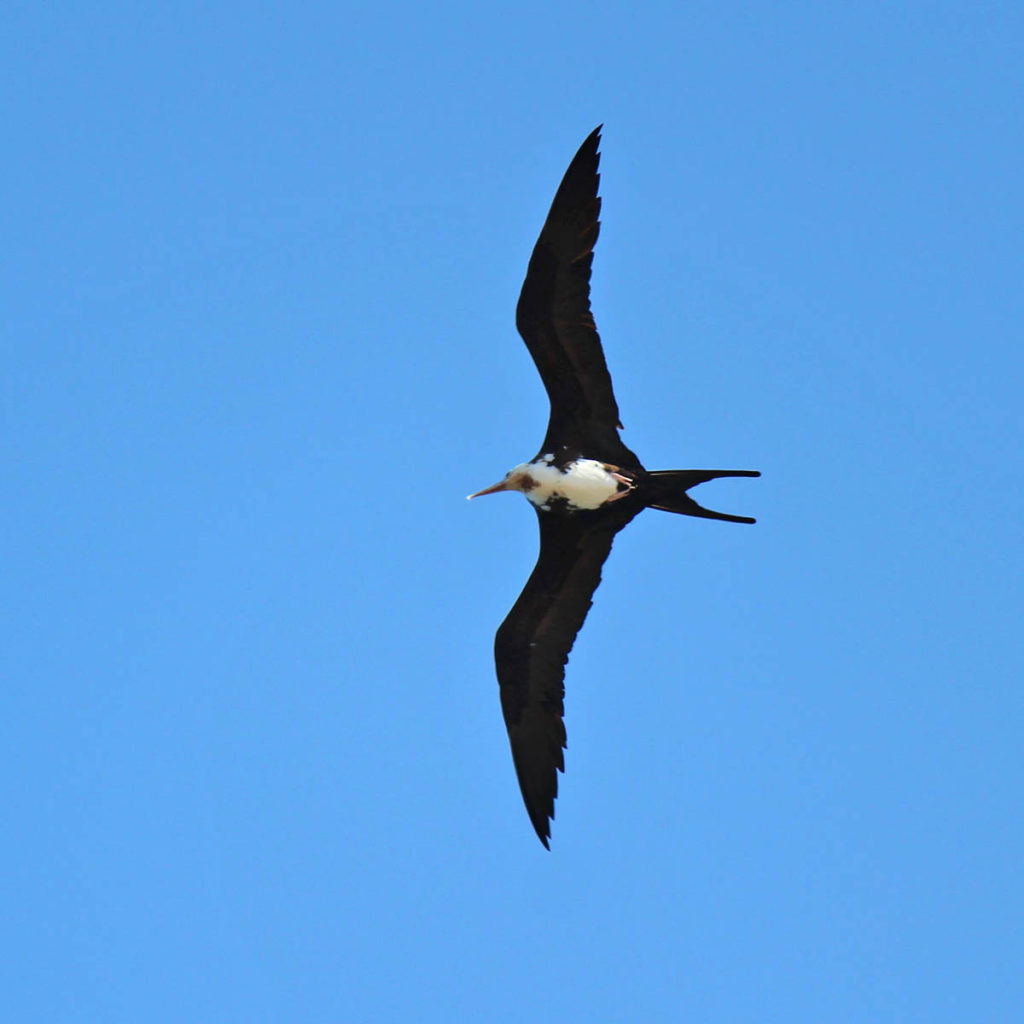
ʻIwa - Fregata minor
The ‘iwa or great frigatebird is a large, agile seabird that breeds on small remote islands across the Pacific. It harasses other seabirds for food and preys on flying fish and squid, nesting in bushes and trees in colonies. In Hawai‘i, it breeds on protected predator-free islands in the Northwestern Hawaiian Islands. Populations appear stable, though potentially threatened by habitat degradation and overfishing. Continued colony protection and ecosystem-based fisheries management are important for this wide-ranging Hawaiian seabird. Monitoring and research on interactions with predatory fish are also needed.
Kākāwahie - Paroreomyza flammea
The kākāwahie is a small, insectivorous Hawaiian honeycreeper endemic to Moloka’i that is likely extinct. Males were scarlet red while females were rust-colored, foraging in wet forests for invertebrates. Once common across eastern Moloka’i, it declined rapidly in the late 1800s and was last observed in 1963. Disease and habitat degradation likely caused its extinction. Now probably extinct, specific conservation actions are not possible. Surveys could confirm if this tragically vanished bird persists.
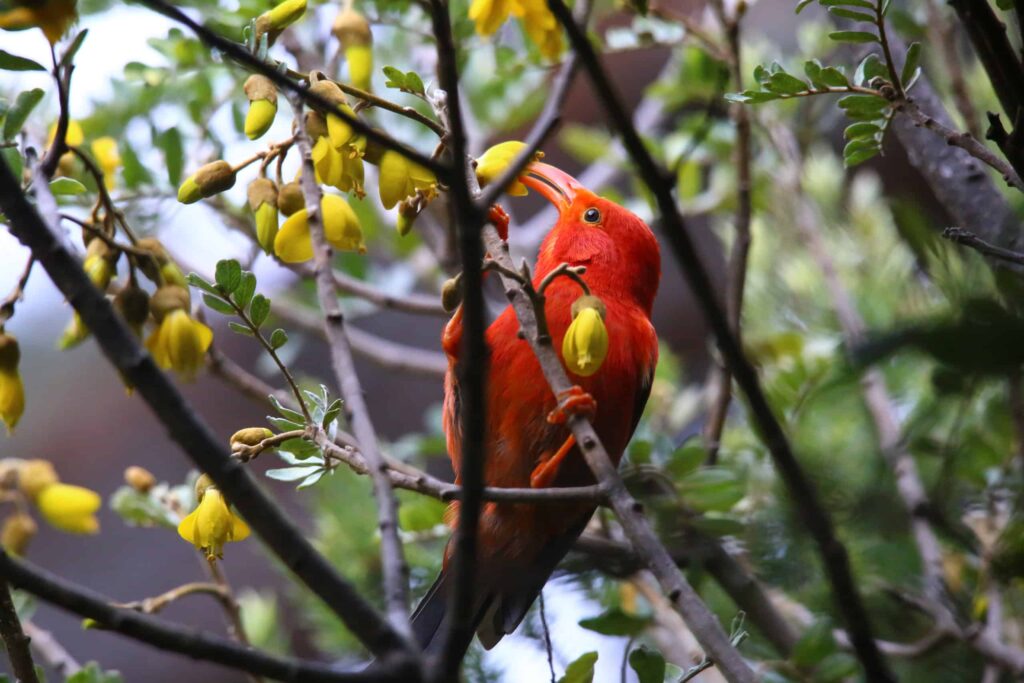
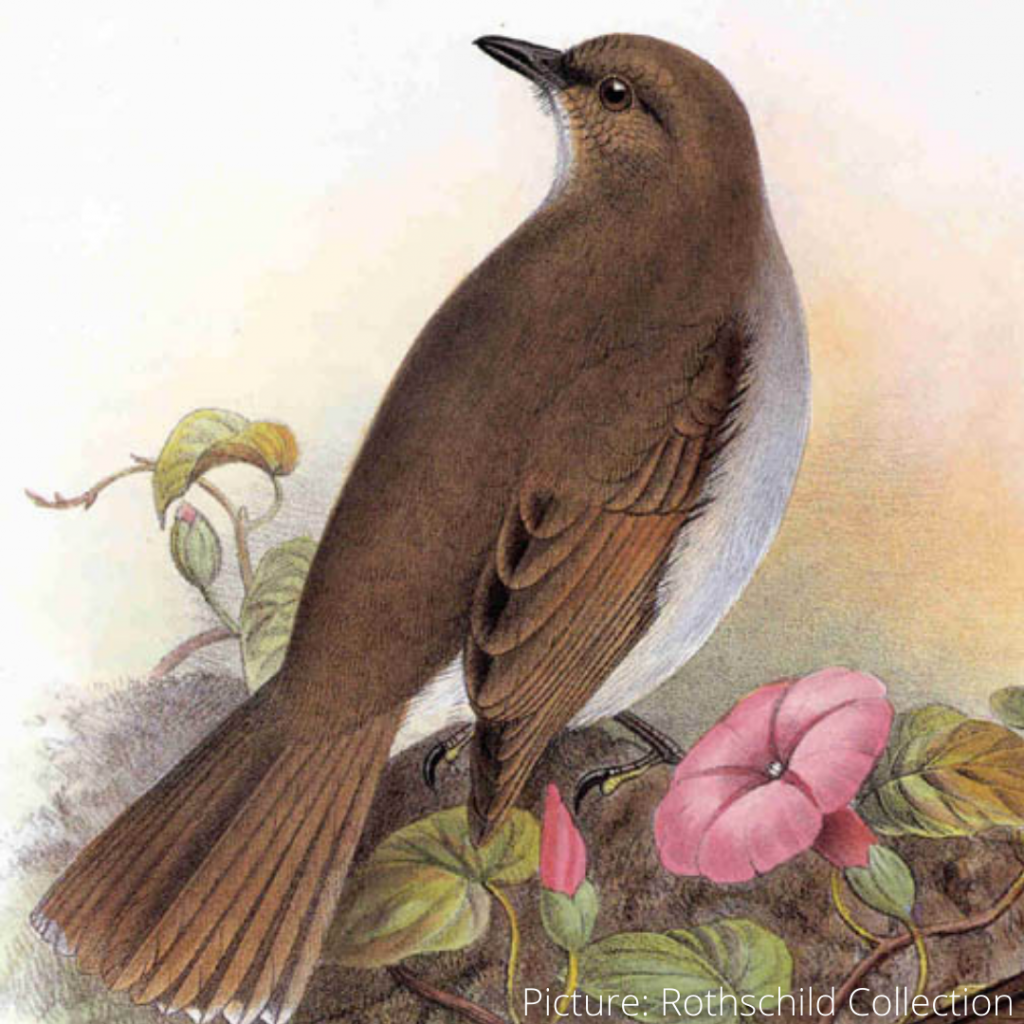
Kāma‘o - Myadestes myadestinus
The kāma’o is a large Hawaiian thrush endemic to Kaua’i that is likely extinct. It had olive-brown plumage and a complex song, feeding on fruit and insects in native forests. Once extremely common across the island, it declined rapidly from disease and habitat loss. Restricted to high elevations since the 1960s, the last observation was in 1989. Now probably extinct, specific conservation actions are limited. Surveys could confirm if this unique Hawaiian forest bird still persists.
Koʻae Kea - Phaethon lepturus
The white-tailed tropicbird is a seabird found in Hawai’i and on other Pacific islands. It has mostly white plumage with some black markings on the wings and around the eyes. It has very long, thin, white tail feathers. The white-tailed tropicbird nests in colonies on cliffs and feeds far out at sea by plunge diving for fish. Its worldwide population is estimated to be less than 200,000 breeding pairs. In Hawai’i, the white-tailed tropicbird population is approximately 1,800 breeding pairs.
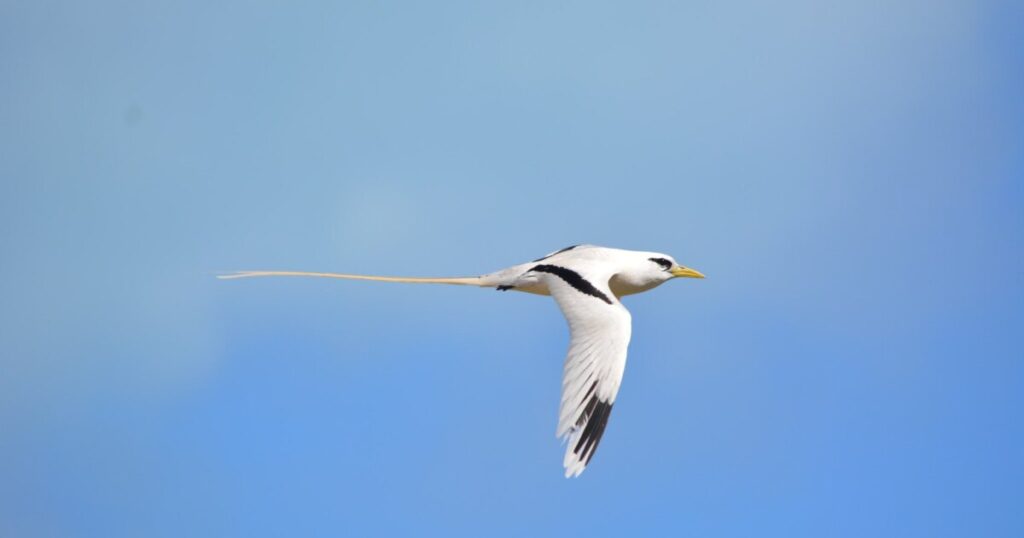
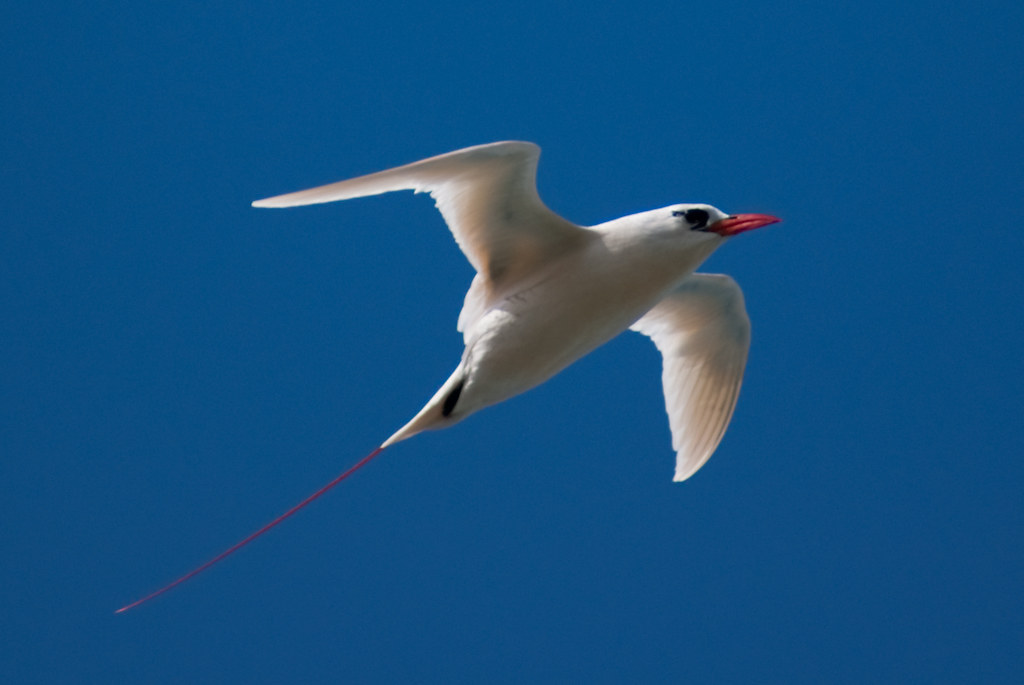
Koʻae ʻUla - Phaethon rubricauda
The koa’e ‘ula or red-tailed tropicbird is a distinctive white seabird that plunge-dives for fish and breeds in colonies on islands. In Hawai’i, it nests on protected predator-free Northwestern Hawaiian Islands and offshore islets. Populations number 9,000-12,000 pairs, with the largest on Midway Atoll and Laysan. Though apparently secure globally, threats include introduced predators like rats and habitat degradation. Continued protection and restoration of breeding colonies are vital for this pelagic species. Long-term monitoring and demographic research are also needed.
Koloa maoli - Anas wyvilliana
The Hawaiian duck, also known as the koloa maoli, is a small brown duck endemic to Hawai’i. It inhabits freshwater wetlands at elevations from sea level to 9,900 feet. The Hawaiian duck is omnivorous, feeding on aquatic plants and invertebrates. Its population declined historically due to hunting and habitat loss but has rebounded to around 2,200 individuals. The koloa maoli is threatened by hybridization with mallards and loss of wetland habitat. Conservation efforts include habitat protection and removal of non-native mallards and hybrids.
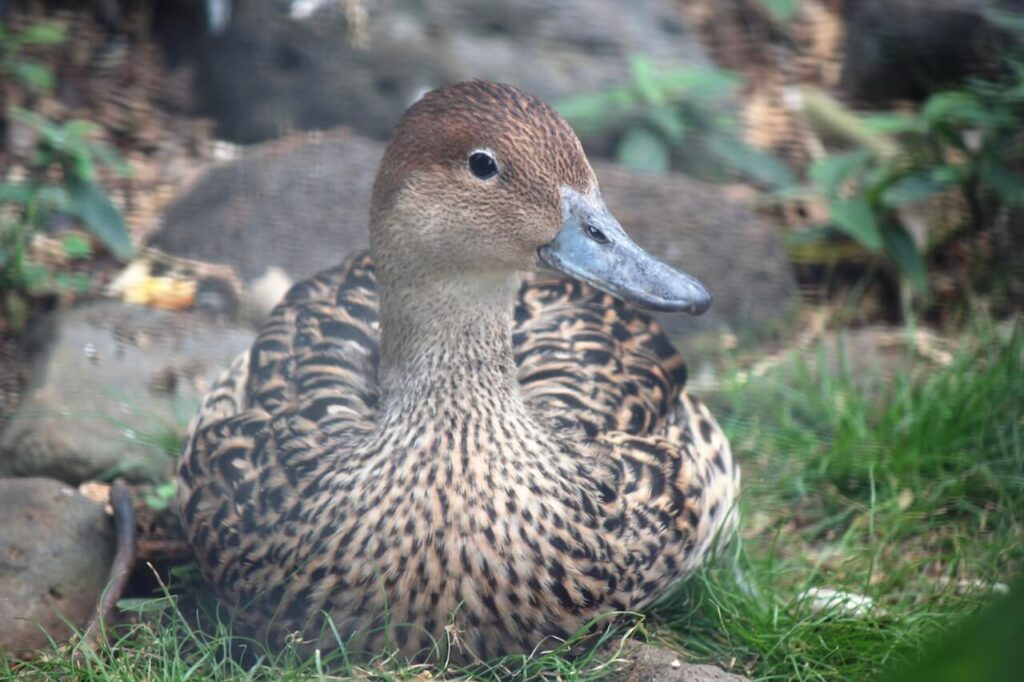
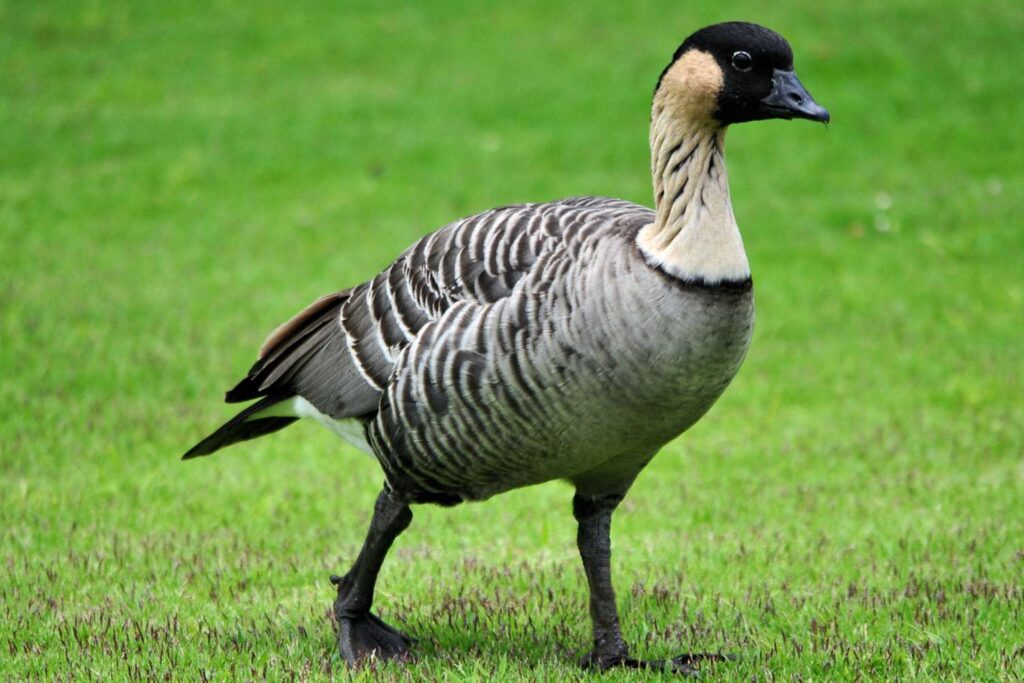
Nēnē - Branta sandvicensis
The nēnē, or Hawaiian goose, is Hawaii’s state bird and the only surviving native goose species. It has dark brown plumage with a black face and cream-colored cheeks. Nēnē inhabit a variety of habitats from coastal dunes to alpine areas. From a low of 30 individuals in the 1950s, the wild population has recovered to about 2,500 birds due to captive breeding and release programs. Threats to nēnē include non-native predators, vehicle collisions, nutritional deficiencies, and disease. The nēnē plays an important ecological role in dispersing seeds and influencing plant community composition in Hawaii.
Nihoa finch - Telespiza ultima
The Nihoa finch is a small Hawaiian honeycreeper endemic to Nihoa Island in the Northwestern Hawaiian Islands. It has yellow and black plumage with differences between males and females. Nihoa finches inhabit rocky, shrub-covered habitat and feed on seeds, fruits, leaves, and invertebrates. With a population around 2,800 birds, the Nihoa finch is threatened by severe weather, food supply fluctuations, and potential introduction of predators. Conservation efforts focus on maintaining the island’s native ecosystem through quarantines and controlling invasive species. The remote Nihoa finch remains highly vulnerable due to its restricted range and small population size.
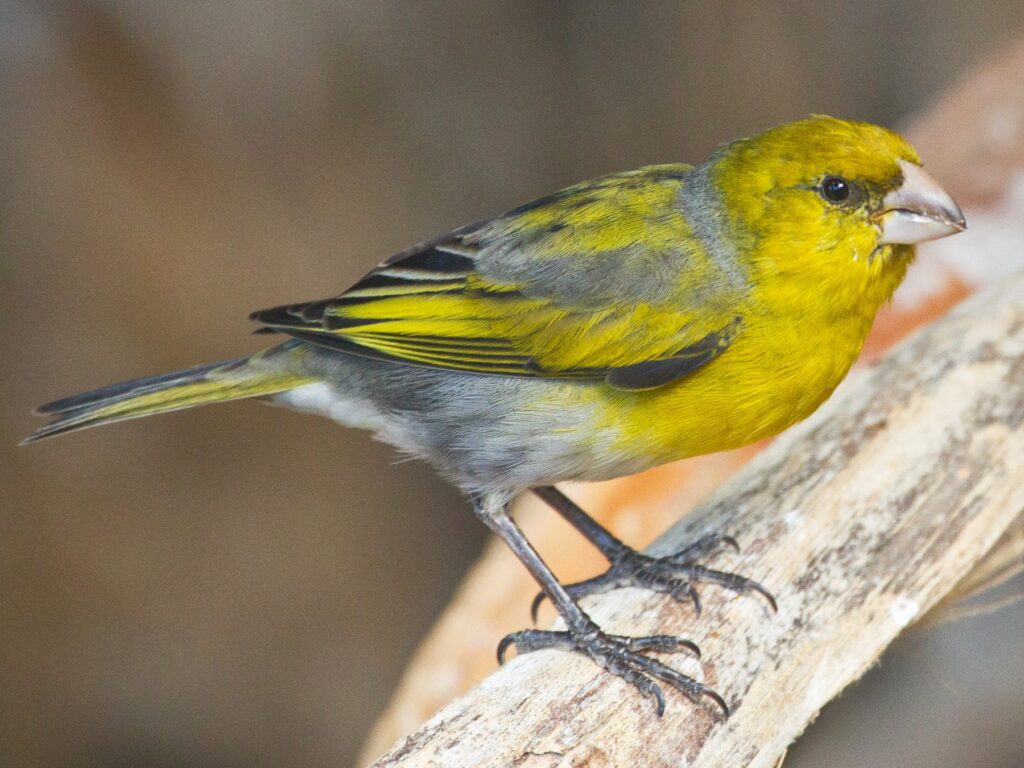
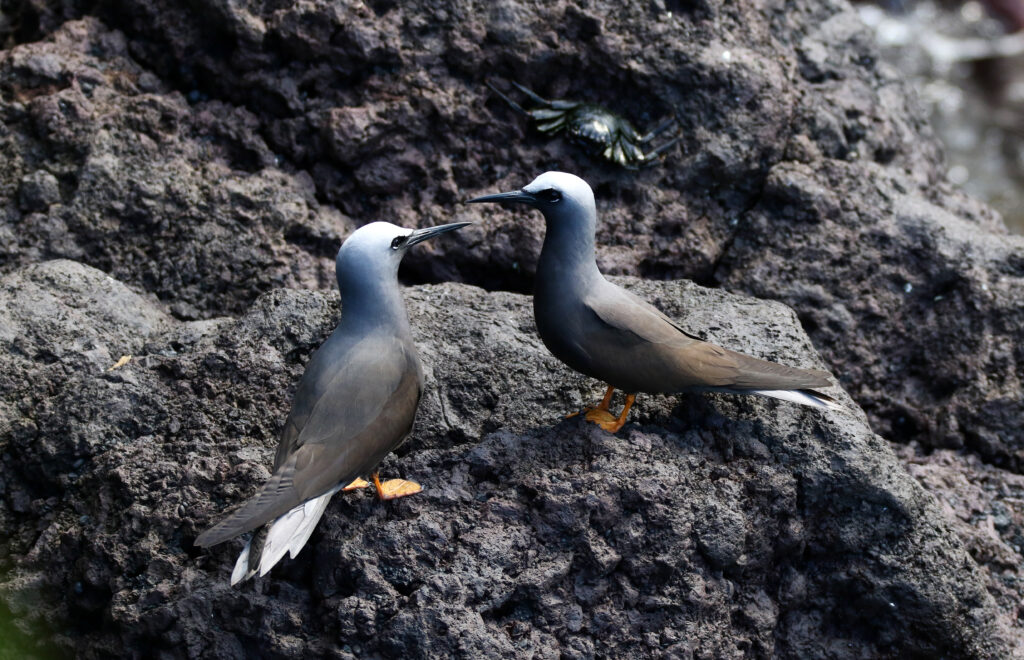
Noio - Anous minutus
The noio or black noddy is a medium-sized, sooty black tern with a white cap that is found throughout the Hawaiian Islands. It nests in large colonies on cliffs and offshore islets, laying a single egg that is incubated by both parents. Noio forage nearshore, feeding on small fish by dipping and diving. With an estimated 12,000 breeding pairs in Hawaii, threats include introduced predators, habitat degradation, human disturbance, pollution, and overfishing. Conservation efforts focus on protecting breeding colonies, controlling non-native species, and reducing disturbance. The noio remains relatively common due to its resilience and broad distribution across the Pacific.
Noio Kāhā - Anous stolidus
The noio kōhā or brown noddy is a medium-sized, dark brown tern with a white cap found across the Hawaiian Islands. It nests in large colonies on the ground or in trees, laying a single egg incubated by both parents. Noio kōhā forage nearshore, feeding on fish and squid by dipping and diving. With an estimated 112,000 breeding pairs in Hawaii, it remains common and widespread in the Pacific. Potential threats include introduced predators at nesting sites and depletion of food sources from overfishing. Conservation efforts focus on protecting breeding colonies and controlling non-native predators.
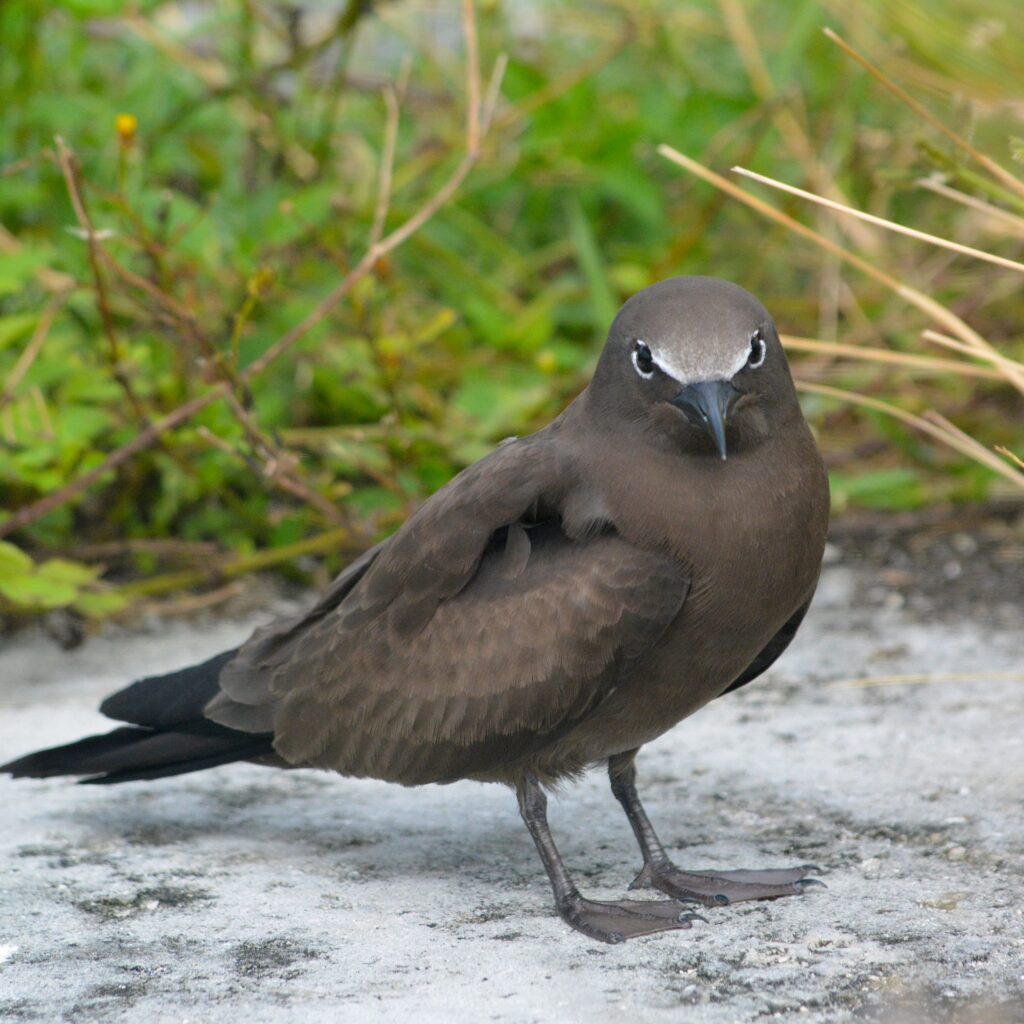
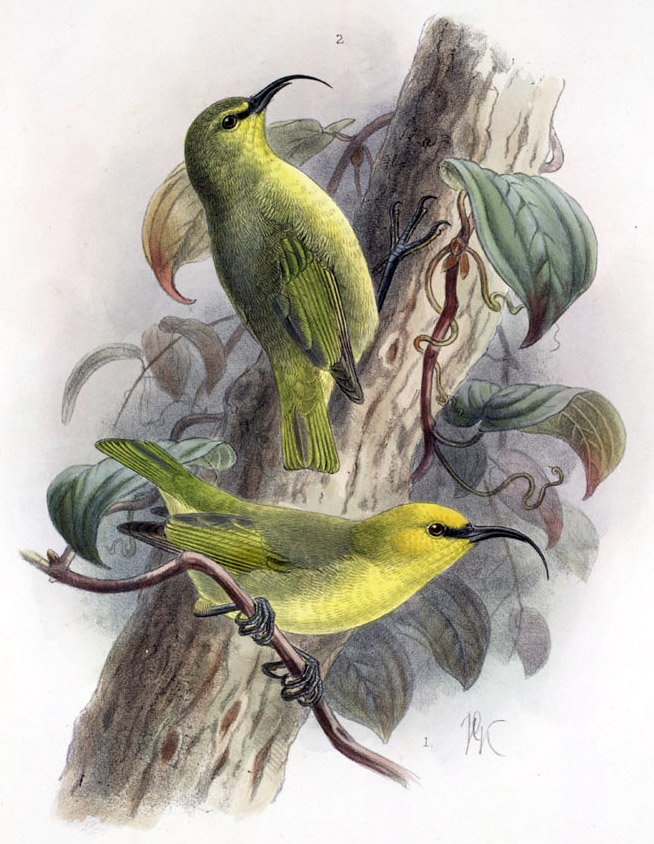
Nuku Pu‘u (Kauaʻi) - Hemignathus lucidus hanapepe
The Kaua’i nuku pu’u is an extinct species of Hawaiian honeycreeper that was endemic to Kaua’i. It had olive green and yellow plumage with a long, curved bill. The Kaua’i nuku pu’u inhabited montane forests where it likely fed on arthropods and nectar. With no confirmed sightings since the 1980s, the species declined due to habitat loss, disease, and predators and is now classified as critically endangered and potentially extinct. Very little is known about the Kaua’i nuku pu’u’s biology as it disappeared before being thoroughly studied. The extinction of the Kaua’i nuku pu’u reflects the extreme vulnerability of Hawaii’s forest birds.
Nuku Pu‘u (Maui) - Hemignathus lucidus affinus
The Maui nuku pu’u is an extinct species of Hawaiian honeycreeper that was endemic to Maui. It had olive green and yellow plumage with a long, curved bill. The Maui nuku pu’u inhabited montane forests where it likely fed on arthropods and nectar. With no confirmed sightings since the 1980s, the species declined due to habitat loss, disease, and predators and is now classified as critically endangered and potentially extinct. Very little is known about the Maui nuku pu’u’s biology as it disappeared before being thoroughly studied. The extinction of the Maui nuku pu’u reflects the extreme vulnerability of Hawaii’s forest birds.
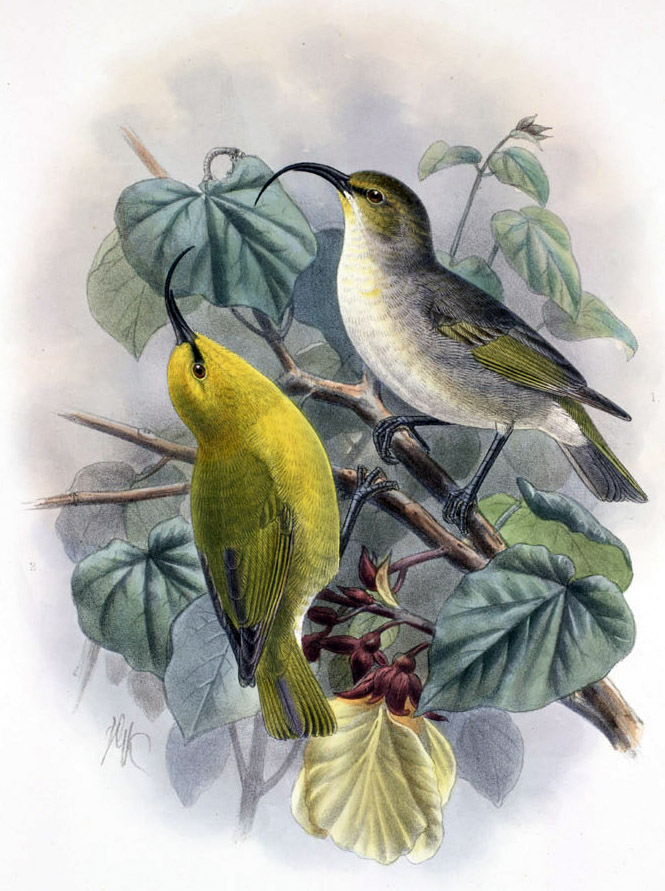
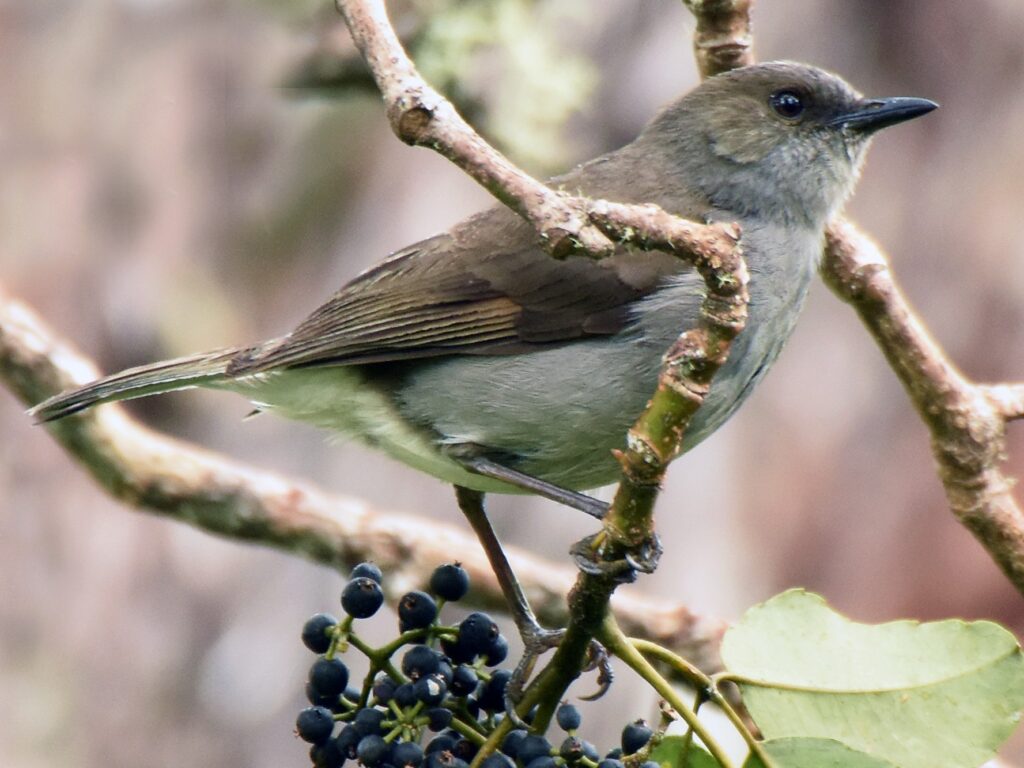
ʻOlomaʻo - Myadestes lanaiensis rutha
ʻOlomaʻo – Myadestes lanaiensis rutha
The oloma’o is an extinct species of Hawaiian thrush that was endemic to Moloka’i and Lanai. It had olive-brown and gray plumage and a melodious song like other Hawaiian thrushes. The oloma’o inhabited dense, wet forests and fed on fruit and insects. It was last reliably observed in 1988 and likely declined due to habitat loss, predators, and disease. The oloma’o is classified as critically endangered and possibly extinct by the IUCN Red List. Very little is known about the oloma’o’s biology as it disappeared before being thoroughly studied.
‘Ōma‘o - Myadestes obscurus
The ‘ōma’o is a species of Hawaiian thrush endemic to the island of Hawaii. It has drab, olive-brown plumage and is best known for its melodious song. The ‘ōma’o inhabits wet forests at elevations above 3,300 feet where it feeds on native fruits and insects. Population estimates indicate around 170,000 ‘ōma’o remain, making it one of the more abundant native Hawaiian forest birds. Threats include habitat degradation, introduced predators, and disease. The ‘ōma’o has likely benefited from conservation efforts to protect high elevation forest habitat on Hawaii.
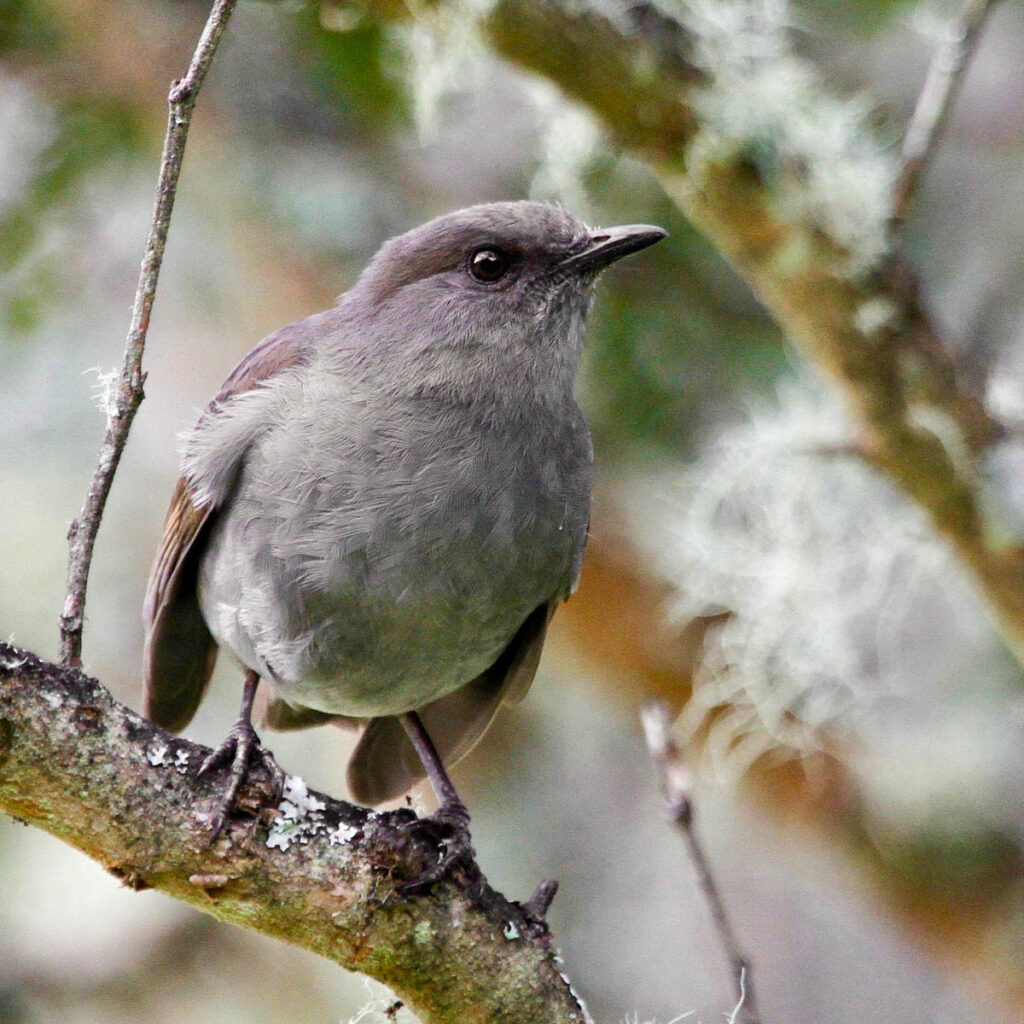

ʻŌʻō (Kauaʻi) - Moho braccatus
The Kaua’i ‘ō’ō is an extinct species of Hawaiian honeycreeper that was endemic to Kaua’i. It had drab plumage and was the smallest of the Hawaiian ‘ō’ō species. The Kaua’i ‘ō’ō inhabited wet forests where it fed on nectar, fruits, and arthropods. It declined due to habitat loss, disease, and predators, with the last sighting in 1987, and is now classified as extinct. Very little is known about the Kaua’i ‘ō’ō’s biology as it disappeared before being thoroughly studied. The Kaua’i ‘ō’ō’s extinction illustrates the vulnerability of Hawaii’s native forest birds.
